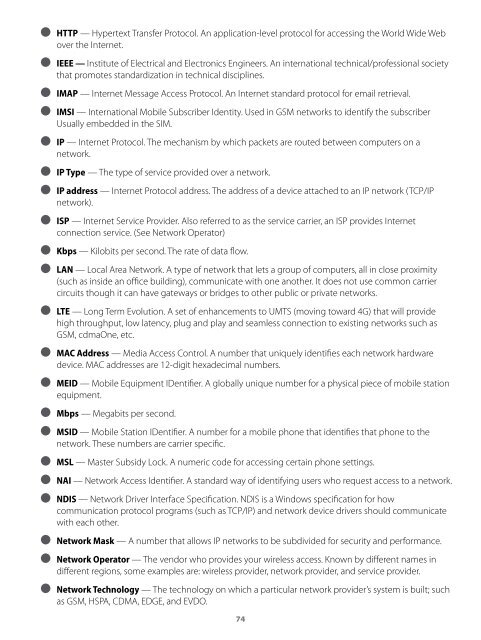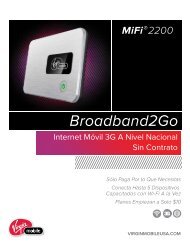Broadband2go - Virgin Mobile USA
Broadband2go - Virgin Mobile USA
Broadband2go - Virgin Mobile USA
You also want an ePaper? Increase the reach of your titles
YUMPU automatically turns print PDFs into web optimized ePapers that Google loves.
● HTTP — Hypertext Transfer Protocol. An application-level protocol for accessing the World Wide Web<br />
over the Internet.<br />
● IEEE — Institute of Electrical and Electronics Engineers. An international technical/professional society<br />
that promotes standardization in technical disciplines.<br />
● IMAP — Internet Message Access Protocol. An Internet standard protocol for email retrieval.<br />
● IMSI — International <strong>Mobile</strong> Subscriber Identity. Used in GSM networks to identify the subscriber<br />
Usually embedded in the SIM.<br />
● IP — Internet Protocol. The mechanism by which packets are routed between computers on a<br />
network.<br />
● IP Type — The type of service provided over a network.<br />
● IP address — Internet Protocol address. The address of a device attached to an IP network (TCP/IP<br />
network).<br />
● ISP — Internet Service Provider. Also referred to as the service carrier, an ISP provides Internet<br />
connection service. (See Network Operator)<br />
● Kbps — Kilobits per second. The rate of data flow.<br />
● LAN — Local Area Network. A type of network that lets a group of computers, all in close proximity<br />
(such as inside an office building), communicate with one another. It does not use common carrier<br />
circuits though it can have gateways or bridges to other public or private networks.<br />
● LTE — Long Term Evolution. A set of enhancements to UMTS (moving toward 4G) that will provide<br />
high throughput, low latency, plug and play and seamless connection to existing networks such as<br />
GSM, cdmaOne, etc.<br />
● MAC Address — Media Access Control. A number that uniquely identifies each network hardware<br />
device. MAC addresses are 12-digit hexadecimal numbers.<br />
● MEID — <strong>Mobile</strong> Equipment IDentifier. A globally unique number for a physical piece of mobile station<br />
equipment.<br />
● Mbps — Megabits per second.<br />
● MSID — <strong>Mobile</strong> Station IDentifier. A number for a mobile phone that identifies that phone to the<br />
network. These numbers are carrier specific.<br />
● MSL — Master Subsidy Lock. A numeric code for accessing certain phone settings.<br />
● NAI — Network Access Identifier. A standard way of identifying users who request access to a network.<br />
● NDIS — Network Driver Interface Specification. NDIS is a Windows specification for how<br />
communication protocol programs (such as TCP/IP) and network device drivers should communicate<br />
with each other.<br />
● Network Mask — A number that allows IP networks to be subdivided for security and performance.<br />
● Network Operator — The vendor who provides your wireless access. Known by different names in<br />
different regions, some examples are: wireless provider, network provider, and service provider.<br />
● Network Technology — The technology on which a particular network provider’s system is built; such<br />
as GSM, HSPA, CDMA, EDGE, and EVDO.<br />
74





